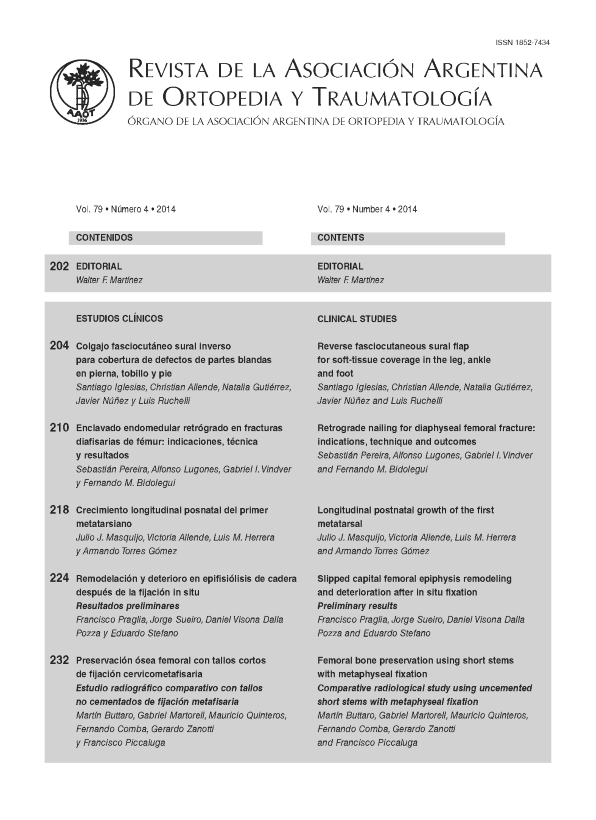Longitudinal postnatal growth of the first metatarsal bone
Main Article Content
Abstract
Downloads
Metrics
Article Details

This work is licensed under a Creative Commons Attribution-NonCommercial-ShareAlike 4.0 International License.
Manuscript acceptance by the Journal implies the simultaneous non-submission to any other journal or publishing house. The RAAOT is under the Licencia Creative Commnos Atribución-NoComercial-Compartir Obras Derivadas Igual 4.0 Internacional (CC-BY-NC.SA 4.0) (http://creativecommons.org/licences/by-nc-sa/4.0/deed.es). Articles can be shared, copied, distributed, modified, altered, transformed into a derivative work, executed and publicly communicated, provided a) the authors and the original publication (Journal, Publisher and URL) are mentioned, b) they are not used for commercial purposes, c) the same terms of the license are maintained.
In the event that the manuscript is approved for its next publication, the authors retain the copyright and will assign to the journal the rights of publication, edition, reproduction, distribution, exhibition and communication at a national and international level in the different databases. data, repositories and portals.
It is hereby stated that the mentioned manuscript has not been published and that it is not being printed in any other national or foreign journal.
The authors hereby accept the necessary modifications, suggested by the reviewers, in order to adapt the manuscript to the style and publication rules of this Journal.
References
2009.
2. Roche AF. The sites of elongation of human metacarpals and metatarsals. Acta Anat 1965;61:193-202.
3. Pyle I, Sontag LW. Variability in onset of ossification in epiphyses and short bones of the extremities. Am J Roentgenol
1943;49:795-8.
4. Holden D, Siff S, Butler J, Cain T. Shortening of the first metatarsal as a complication of metatarsal osteotomies. J Bone Joint
Surg Am 1984;66(4):582-7.
5. Gardner E, Gray DJ, O’Rahilly R. The prenatal development of the skeleton and joints of the human foot. J Bone Joint Surg
Am 1959;41:847-76.
6. Anderson M, Blais MM, Green WT. Lengths of the growing foot. J Bone Joint Surg Am 1956;38:998-1000.
7. Anderson M, Green WT. Lengths of the femur and the tibia; norms derived from orthoroentgenograms of children from 5 years
of age until epiphysial closure. Am J Dis Child 1948;75:279-90.
8. Anderson M, Blais M, Green WT. Growth of the normal foot during childhood and adolescence; length of the foot and
interrelations of foot, stature, and lower extremity as seen in serialrecords of children between 1–18 years of age. Am J Phys
Anthropol 1956;14:287-308.
9. Lamm BM, Paley D, Kurland DB, Matz AL, Herzenberg JE. Multiplier method for predicting adult foot length. J Pediatr
Orthop 2006;26(4):444-8.
10. McGraw MA, Mehlman CT, Lindsell CJ, Kirby CL. Postnatal growth of the clavicle: birth to eighteen years of age. J Pediatr
Orthop 2009;29(8):937-43.
11. Parikh SN, Weesner M, Welge J. Postnatal growth of the calcaneus does not simulate growth of the foot. J Pediatr Orthop
2012;32(1):93-9.
12. de Vasconcellos HA, Prates JC, Moraes LG, Rodriques HC. Growth of the human metatarsal bones in the fetal period (13-24
weeks postconception): a quantitative study. Surg Radiol Ana. 1992;14(4):315-8.
13. Simons GWA. Standardized method for the radiographic evaluation of clubfeet. Clin Orthop Relat Res 1978;135:107-18.

